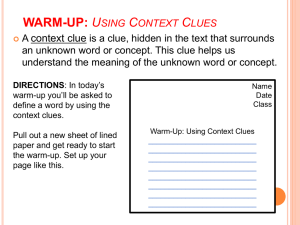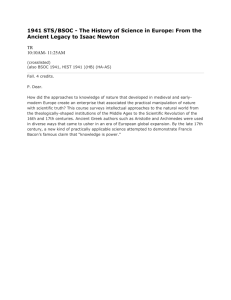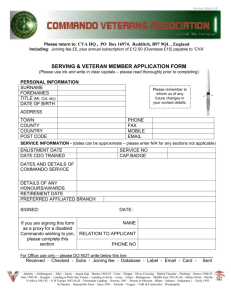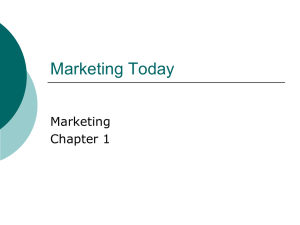Essential Question:
advertisement
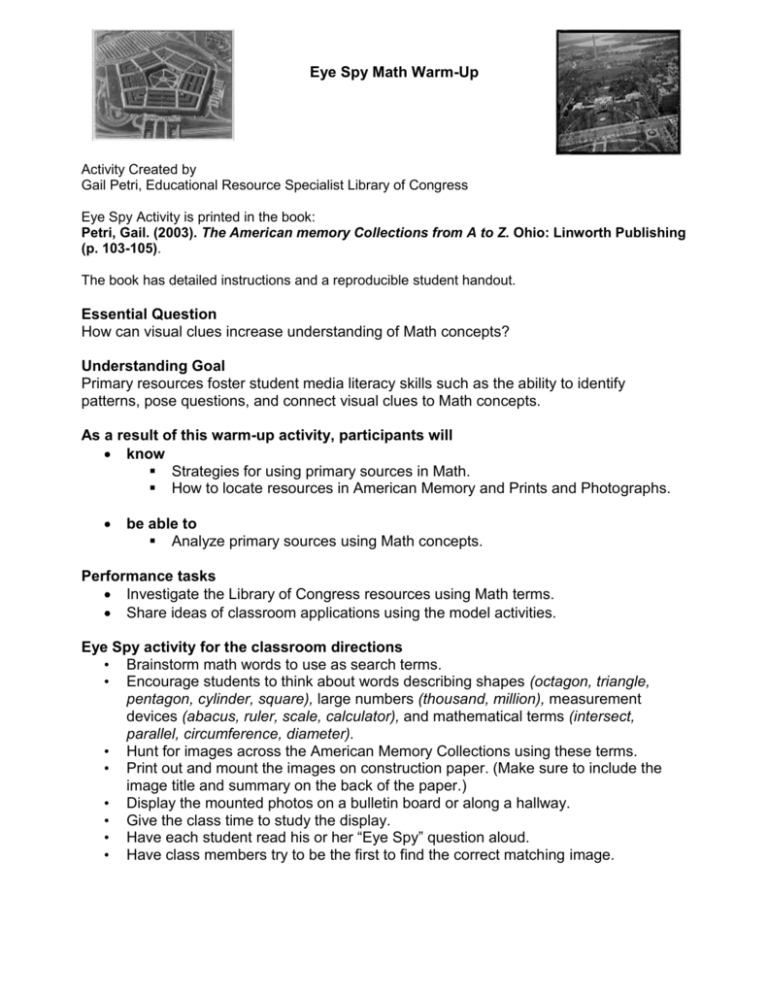
Eye Spy Math Warm-Up Activity Created by Gail Petri, Educational Resource Specialist Library of Congress Eye Spy Activity is printed in the book: Petri, Gail. (2003). The American memory Collections from A to Z. Ohio: Linworth Publishing (p. 103-105). The book has detailed instructions and a reproducible student handout. Essential Question How can visual clues increase understanding of Math concepts? Understanding Goal Primary resources foster student media literacy skills such as the ability to identify patterns, pose questions, and connect visual clues to Math concepts. As a result of this warm-up activity, participants will know Strategies for using primary sources in Math. How to locate resources in American Memory and Prints and Photographs. be able to Analyze primary sources using Math concepts. Performance tasks Investigate the Library of Congress resources using Math terms. Share ideas of classroom applications using the model activities. Eye Spy activity for the classroom directions • Brainstorm math words to use as search terms. • Encourage students to think about words describing shapes (octagon, triangle, pentagon, cylinder, square), large numbers (thousand, million), measurement devices (abacus, ruler, scale, calculator), and mathematical terms (intersect, parallel, circumference, diameter). • Hunt for images across the American Memory Collections using these terms. • Print out and mount the images on construction paper. (Make sure to include the image title and summary on the back of the paper.) • Display the mounted photos on a bulletin board or along a hallway. • Give the class time to study the display. • Have each student read his or her “Eye Spy” question aloud. • Have class members try to be the first to find the correct matching image. Unit Topic Number and Number Sense/ Computation Overview of lesson Students will identify and describe clues in the photo which support that the picture is from the past. They will then write and compare the numbers 1941and 2004 to see which is greater, calculate the difference between these two numbers, and round each number to calculate how many decades ago this photo was taken. Enduring understanding As a result of this warm-up, students will understand: Dates in the past are numerically less than current dates and can be rounded to the nearest decade to help with estimation. Content Knowledge As a result of warm-up, students will know: The number 1941 is less than the number 2004 When 1941 refers to a year the year is in the past relative to the year 2004 These two dates are 6 decades apart (about 60 years) Skills As a result of this warm-up, students will be able to: Say and write the year hundred forty one and two thousand four Subtract these two numbers Calculate the number of decades these dates are apart SOLs Addressed Number and Number Sense: The student will: 3.1 read and write *six-digit numerals and identify the place value for each digit. (*These are four-digit numerals) 3.2 round a whole number, 9,999 or less to the nearest ten. 3.3 compare two whole numbers between 0 and 9,999, using symbols and words. Computation and Estimation: The student will: 3.8 solve problems involving the sum or difference of two whole numbers, each 9,999 or less, using various computational methods, paper and pencil and estimation. Length of Warm-up 15 minutes Prior Knowledge Familiarity with the concept of "greater than," "less than," or "equal to." The students will also need to know how to subtract four digit numbers and how to round to the nearest ten. Resources needed Library of Congress Resource with title and permanent URL: Three men seated at table with checkerboards, spectators looking on http://memory.loc.gov/cgibin/query/r?ammem/toddbib:@field(DOCID+@lit(p019)) Process of lesson 1. Ask the students to examine the photo and to look for clues that tell if the photo was taken recently or in the past. Circle the clues. (The clothes, hat, suspenders, the checkers boxes). 2. Share with the students that the photo was taken in 1941. Ask the students to write that number in two different ways - using numbers and using words. Ask the students to write the current year in numbers and words also. 3. Have the students compare the numbers 1941 and 2004 to see which is greater using the correct terminology and symbol. (2004 is greater than 1941 and/or 1941 is less than 2004; 2004 >1941 and/or 1941 < 2004) 4. Ask the students to round each number to the nearest ten (1940 & 2000). Explain how a decade consists of ten years. Have the students figure out how many decades ago this photo was taken (6 decades). Evaluation Evaluate the students as they move through each process. Check their papers as they complete each step. Based on the students’ levels they can perform the steps individually, in a group or as a class. Collect their warm-up papers for further evaluation. Extension Activities Students could: Identify geometric shapes used in the game of checkers (circles and squares) Describe patterns using a checker board (The black and red squares and when the markers are placed on the squares in various ways) Use the checker board to create patterns with the markers Use the checker board to find congruent and similar figures (squares) Give the students some other dates and have them round to the nearest ten to estimate the number of decades between the dates.

